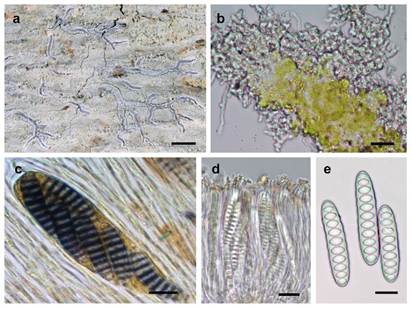Allographa effusosoredica

- 20 Jul 2025
In News:
A team of Indian scientists from MACS-Agharkar Research Institute, Pune (under the Department of Science & Technology) has discovered a new species of lichen named Allographa effusosoredica in the Western Ghats, a UNESCO World Heritage Site and biodiversity hotspot. This crustose lichen exhibits effuse soredia and contains norstictic acid, a rare secondary metabolite within its genus.
Scientific and Molecular Significance
- The species was examined through polyphasic taxonomy, integrating:
- Morphological traits
- Chemical profiling
- Molecular sequencing using genetic markers:
- Fungal DNA markers: mtSSU, LSU, RPB2
- Algal symbiont marker: ITS
- The lichen’s photobiont was identified as a species of Trentepohlia, advancing the understanding of tropical algal diversity in lichens.
- Though morphologically similar to Graphis glaucescens, it is phylogenetically closest to Allographa xanthospora.
Symbiosis in Lichens
- Lichens are composite organisms, formed by a symbiotic association between:
- A fungal partner (mycobiont) — provides structure and protection.
- A photosynthetic partner (photobiont), such as green algae or cyanobacteria — produces nutrients via photosynthesis.
- This discovery supports the concept of locally adapted symbiosis, emphasizing co-evolution in tropical ecosystems.
Ecological Importance of Lichens
- Lichens are vital for:
- Soil formation
- Feeding insect populations
- Acting as bioindicators of air quality and ecosystem health.
Conservation and Biodiversity Impact
- Allographa effusosoredica is:
- The 53rd Allographa species reported from India.
- The 22nd species of this genus documented in the Western Ghats.
- The first Indian Allographa species validated using molecular tools.
- The study was supported by the Anusandhan National Research Foundation (ANRF) and contributes to the growing inventory of India’s cryptic biodiversity.
